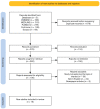Waterpipe Use and Its Cardiovascular Effects: A Systematic Review and Meta-Analysis of Case-Control, Cross-Sectional, and Non-Randomized Studies
- PMID: 36915837
- PMCID: PMC10008028
- DOI: 10.7759/cureus.34802
Waterpipe Use and Its Cardiovascular Effects: A Systematic Review and Meta-Analysis of Case-Control, Cross-Sectional, and Non-Randomized Studies
Abstract
Approximately 100 million people globally smoke cigarettes, making it a significant and quickly spreading global tobacco epidemic. Substance use disorders are frequently evaluated by non-randomized studies. Tobacco use and its impacts on the cardiovascular system were the subjects of a comprehensive search across five electronic databases: Cochrane, MEDLINE, Scopus, Embase, and PubMed. The findings demonstrated that waterpipe smokers in comparison to non-smokers have immediate elevations in heart rate and blood pressure, lower levels of high-density lipoprotein, higher levels of low-density lipoprotein, higher levels of triglycerides, higher levels of fasting blood glucose, and a higher heart rate. Users of waterpipes and cigarettes had similar average heart rates, blood pressure, and lipid levels, with the exception that waterpipe smokers had greater total cholesterol. Smoking a waterpipe has significant negative effects on the cardiovascular system comparable to cigarette smoking, and non-randomized studies proved to yield substantial evidence related to its cardiovascular effects. Such study designs can be used to evaluate substance use and its cardiovascular impact.
Keywords: cardiovascular disease; heated tobacco products; non-randomized studies; tobacco use disorder; waterpipe.
Copyright © 2023, Mahfooz et al.
Conflict of interest statement
The authors have declared that no competing interests exist.
Figures







References
Publication types
LinkOut - more resources
Full Text Sources
